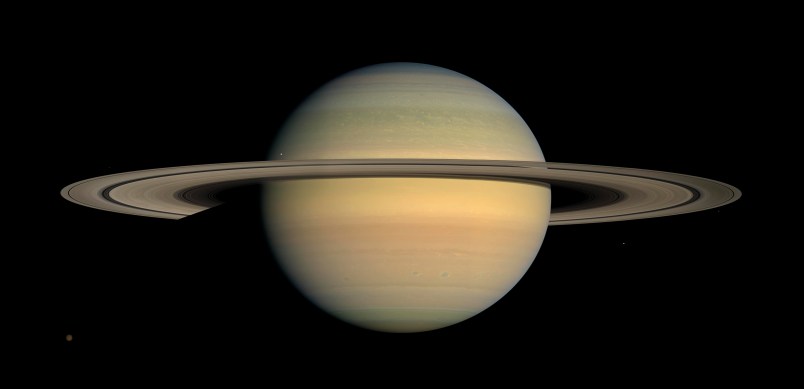CAPE CANAVERAL, Fla. (AP) — NASA’s Cassini spacecraft disintegrated in the skies above Saturn early Friday in a final, fateful blaze of cosmic glory, following a remarkable journey of 20 years.
Confirmation of Cassini’s expected demise came about 7:55 a.m. EDT. That’s when radio signals from the spacecraft — its last scientific gifts to Earth — came to an abrupt halt. The radio waves went flat, and the spacecraft fell silent.
Cassini actually burned up like a meteor 83 minutes earlier as it dove through Saturn’s atmosphere, becoming one with the giant gas planet it set out in 1997 to explore. But it took that long for the news to reach Earth a billion miles away.
The only spacecraft to ever orbit Saturn, Cassini showed us the planet, its rings and moons up close in all their splendor. Perhaps most tantalizing, ocean worlds were unveiled on the moons Enceladus and Titan, which could possibly harbor life.
Dutiful to the end, the Cassini snapped its “last memento photos” Thursday and sampled Saturn’s atmosphere Friday morning as it made its final plunge.
Program manager Earl Maize made the official pronouncement:
“This has been an incredible mission, an incredible spacecraft and you’re all an incredible team,” Maize said. “I’ll call this the end of mission.”
Flight controllers wearing matching purple shirts stood and embraced and shook hands.
More than 1,500 people, many of them past and present team members, had gathered at California’s Jet Propulsion Laboratory for what was described as both a vigil and celebration. Even more congregated at nearby California Institute of Technology, which runs the lab for NASA.
NASA’s science mission director, Thomas Zurbuchen, made note of all the tissues inside JPL’s Mission Control, along with the customary lucky peanuts. Team members were clearly emotional, he said.
“These worlds that they found, we never knew were there, are changing how we think about life itself,” he said. “And so for me, that’s why it’s truly a civilization-scale mission, one that will stand out among other missions, anywhere.”
Project scientist Linda Spilker noted Cassini has been running “a marathon of scientific discovery” for 13 years at Saturn.
“So we’re here today to cheer as Cassini finishes that race,” she said.
The spacecraft tumbled out of control while plummeting at more than 76,000 mph (122,000 kph). Project officials invited ground telescopes to look for Cassini’s last-gasp flash, but weren’t hopeful it would be spotted against the vast backdrop of the solar system’s second biggest planet.
This Grand Finale, as NASA called it, came about as Cassini’s fuel tank started getting low after 13 years exploring the planet. Scientists wanted to prevent Cassini from crashing into Enceladus or Titan — and contaminating those pristine worlds. And so in April, Cassini was directed into the previously unexplored gap between Saturn’s cloud tops and the rings. Twenty-two times, Cassini entered the gap and came out again. The last time was last week.
The leader of Cassini’s imaging team, Carolyn Porco, a visiting scholar at the University of California, Berkeley, was so involved with the mission for so long that now, “I consider it the start of life, part two.”
Cassini departed Earth in 1997 and arrived at the sixth planet from our sun in 2004. The hitchhiking European Huygens landed on big moon Titan in 2005. Nothing from Earth has landed farther. Three other spacecraft previously flew past Saturn, but Cassini was the only one to actually circle the planet.
In all, Cassini collected more than 453,000 images and traveled 4.9 billion miles. It was an international endeavor, with 27 nations taking part. The final price tag was $3.9 billion.
European space officials joined their U.S. colleagues to bid Cassini farewell.
“It’s a very historical moment,” said the Italian Space Agency’s president, Roberto Battiston.
There were lighthearted touches as well. During its broadcast NASA played a video clip of the Cassini Virtual Singers, spacecraft team members who belted out, “Tonight, tonight, we take the plunge tonight …” to the music from “West Side Story.”
Scientists are already eager to go back and delve into the wet, wild worlds of Enceladus and Titan. Proposals are under consideration by NASA, but there’s nothing official yet. In the meantime, NASA plans sometime in the 2020s to send an orbiter and lander to Europa, a moon of Jupiter believed to have a global ocean that might be compatible for life.
“Yes, we really want to go back” to Saturn, Zurbuchen said. “It’s such a wonderful system, we don’t want to leave it alone.”







Amazing!
One item not mentioned here is that this atmospheric self-destruction finish will incinerate any microbes that might be adhering to our robotic space explorer.
We think…
The heat of entry will atomize anything carbon-based. Even metal will turn molten. It will basically be an asteroid-like slag heap by the time it reaches the bottom of Saturn’s enormous gravity well.
Amazing and inspiring that people can build stuff like this. And even still can.